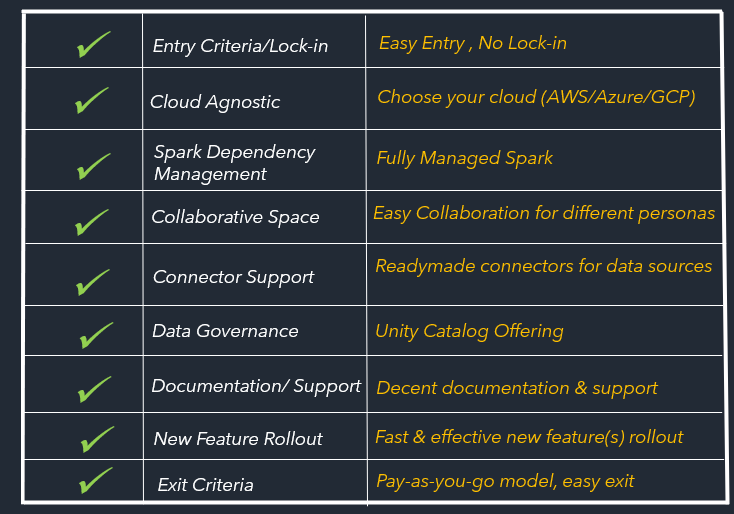What is Databricks?
Databricks is a unified ecosystem which will allow organizations to build, deploy, share and maintain enterprise-grade data solutions. The key aspect of using Databricks is to make use of Delta Lake (Lakehouse) which is best of both worlds Data Lake & Data Warehouse properties. Well, as we go further it will be clearer on what makes databricks the most popular choice at this time, a glance below:

>Easy Entry
Whether you are using On-Prem storage or using any cloud native storage or in hybrid mode, Databricks has connector for almost all popular data stores. You can start even with SFTP to bring your on-prem data to cloud storage and once your data is available in cloud you are good to kick start your analytics journey with Databricks.
>Use your preferred Cloud
Databricks provides an abstraction layer on top of your cloud storage. So, it gives you flexibility to choose you preferred cloud (AWS, Azure or GCP). Even if you have cloud storage in different clouds (say AWS and Azure) then also Databricks works seamlessly. Like consuming data from AWS S3 and writing processed data to Azure ADLS2.
>Fully managed Spark
One of the biggest advantages that Databricks provides is fully managed Spark. All the spark dependencies and best optimization & tuning features are auto enabled in Databricks so data engineers can focus on their domain specific use case. However, you have flexibility to turn on/off any features which may not be required for your workloads.
Spark supports Scala, Python, Java, R and SQL. This covers most famous languages for Data Analysts, Data Scientists and Machine learning experts. You can even write code in different languages in a single notebook. Example one block of code in Python and next block of code in SQL. Very Interesting!
>Collaborative space for Data Analyst, Data Scientists, Business Analysts
Databricks provides Centralized space for collaboration for all project participants. You have flexibility to select your own language for analysis. With same set of data in databricks, a data analyst may like to run SQLs while a data scientist makes use of python ML stack to achieve data patterns and insights.
>Readymade Connectors for Data Sources
Databricks has readymade connectors and many other connectors through third party for seamless data ingestion from wide variety of data sources, To name a few:
- Amazon Redshift
- Azure Synapse Analytics
- Google Big Query
- MongoDB
- Cassandra
- Couchbase
- Elasticsearch
- Snowflake
- Azure Cosmos DB
However, you always have a choice to move data to your data lake (like Amazon S3 or Azure ADLS 2) further and connect from there.
> Data Governance Options
Databricks provides Unity Catalog for data governance to control the access mechanism. This helps in providing Unified data access controls, Data Auditing, Data Quality management, Data Lineage and Data Sharing.
> Decent Documentation & Support
Databricks has a decent documentation available, most up to date blogs, reference notebooks to kick start your analytics journey. You can reach out to support for any issues faced.
>Getting ahead with latest developments
One of the most liked attributes of Databricks by data community is to have access to new rolled out features in public purview (PP) quite promptly and then very soon in General availability (GA). It gives you that edge to try out features as soon as they hit the market, and if you find it viable for your business case, you can implement it. From a Databricks user perspective, it is quite easy to accommodate new feature developments and getting ahead in competition.
> Easy exit
In the rapidly evolving ecosystem, every organization wants to ensure a smooth exit strategy. There is no lock in from databricks, it is a Pay-As-You-Go model. Whatever you have built using Databricks is available to you in industry standard format files. If you wish to exit Databricks, you can immediately do and use your current data in new solution.
Conclusion
We could achieve desired data insights through analytics offerings from AWS/Azure/GCP native service offerings as well, but they need more technical handling and manual integration. Spark dependency management has to be handled, Delta Lake to be setup. Here, technical aspects are a key consideration before moving to business use case.
While, databricks sets a cloud agnostic stage for the organizations to jump start their analytics journey on delta lake. The ease of using Databricks ecosystem, auto management of spark optimizations, native support for upcoming data engineering and machine learning features makes databricks obvious choice for analytics circles. Leveraging databricks organizations can jump start their analytics journey focusing right on their business use cases which makes Databricks – a clear winner!
Databricks - The Clear Winner